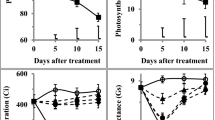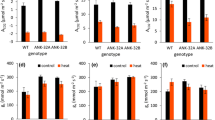Abstract
The fact that molybdenum (Mo) applications can alleviate low temperature stress (LTS) in plants has been widely reported, but the underlying mechanisms are not fully understood. The effects of Mo (0 and 0.15 mg kg−1) on photosynthetic pigments, fatty acids and the chlorophyll–protein complex of wheat seedlings in pot culture were investigated at 0, 2, 4 and 6 days of LTS. Chlorophyll a and b, total chlorophyll and carotenoid contents were significantly enhanced by Mo application. The palmitic acid (C16:0) content and total saturated fatty acids (TSFA) were drastically decreased in wheat cultivar 97003 at 2 and 4 days of LTS and in wheat cultivar 97014 at 2 days of LTS. The linolenic acid (C18:3) content and total unsaturated fatty acids (TUSFA) were significantly increased in both cultivars at 2 and 4 days of LTS. The palmitoleic acid (C16:1) content was also drastically increased in cultivar 97003 at 2 days of LTS, suggesting that Mo induced a greater production of unsaturated fatty acids or the conversion of TSFA to TUSFA. The ratio of unsaturated to saturated fatty acids and the index of unsaturated fatty acids in the thylakoid membranes were enhanced with supplemental Mo, suggesting that Mo might improve the degree of unsaturation. However, no significant differences were observed in the chlorophyll–protein complexes between the +Mo and −Mo treatments. These results indicated that the alteration of fatty acids induced by Mo application in the thylakoid membranes of wheat contributed to LTS tolerance.





Similar content being viewed by others
Abbreviations
- Mo:
-
Molybdenum
- TSFA:
-
Total saturated fatty acids
- TUSFA:
-
Total unsaturated fatty acids
- U/S:
-
Ratio of unsaturated to saturated fatty acids
- IUFA:
-
Index of unsaturated fatty acids
- LHC:
-
Light-harvesting complex
- CPI:
-
Chlorophyll–protein I
- CPII:
-
Chlorophyll–protein II
- LTS:
-
Low temperature stress
References
Adams WI, Demmig-Adams B, Verhoeven AS, Barker DH (1995) Photoinhibition during winter stress: involvement of sustained xanthophyll cycle-dependent energy dissipation. Funct Plant Biol 22:261–276
Al-Issawi M, Rihan HZ, Woldie WA, Burchett S, Fuller MP (2013) Exogenous application of molybdenum affects the expression of CBF14 and the development of frost tolerance in wheat. Plant Physiol Biochem 63:77–81
Aro E, Hundal T, Carlberg I, Andersson B (1990) In vitro studies on light-induced inhibition of photosystem II and D1-protein degradation at low temperatures. BBA Bioenerg 1019:269–275
Castelfranco PA, Zeng X (1991) Regulation of 5-aminolevulinic acid synthesis in developing chloroplasts IV. An endogenous inhibitor from the thylakoid membranes. Plant Physiol 97:1–6
Chintalapati S, Kiran MD, Shivaji S (2004) Role of membrane lipid fatty acids in cold adaptation. Cell Mol Biol 50:631–642
Distefano AM, García Mata C, Lamattina L, Laxalt AM (2008) Nitric oxide-induced phosphatidic acid accumulation: a role for phospholipases C and D in stomatal closure. Plant Cell Environ 31:187–194
Dunahay TG, Staehelin LA, Seibert M, Ogilvie PD, Berg SP (1984) Structural, biochemical and biophysical characterization of four oxygen-evolving photosystem II preparations from spinach. BBA Bioenerg 764:179–193
Guo Y, Liu S, Yang Z, Tian S, Sui N (2016) Responses of unsaturated fatty acid in membrane lipid and antioxidant enzymes to chilling stress in sweet sorghum (Sorghum bicolor (L.) Moench) seedling. J Agric Sci 8:71–83
Janská A, Maršík P, Zelenková S, Ovesna J (2010) Cold stress and acclimation—what is important for metabolic adjustment? Plant Biol 12:395–405
Karabudak T, Bor M, Özdemir F, Türkan İ (2014) Glycine betaine protects tomato (Solanum lycopersicum) plants at low temperature by inducing fatty acid desaturase7 and lipoxygenase gene expression. Mol Biol Rep 41:1401–1410
Krüger G, De Villiers MF, Strauss AJ, de Beer M, van Heerden P, Maldonado R, Strasser RJ (2014) Inhibition of photosystem II activities in soybean (Glycine max) genotypes differing in chilling sensitivity. South Afr J Bot 95:85–96
Laxalt AM, Raho N, Ten Have A, Lamattina L (2007) Nitric oxide is critical for inducing phosphatidic acid accumulation in xylanase-elicited tomato cells. J Biol Chem 282:21160–21168
Li B, Zhang C, Cao B, Qin G, Wang W, Tian S (2012) Brassinolide enhances cold stress tolerance of fruit by regulating plasma membrane proteins and lipids. Amino Acids 43:2469–2480
Li Y, Zhang J, Zhang J, Hao L, Hua J, Duan L, Zhang M, Li Z (2013) Expression of an Arabidopsis molybdenum cofactor sulphurase gene in soybean enhances drought tolerance and increases yield under field conditions. Plant Biotechnol J 11:747–758
Mendel RR (2013) Metabolism of molybdenum. Met Ions Life Sci 12:503–528
Mironov KS, Sidorov RA, Trofimova MS, Bedbenov VS, Tsydendambaev VD, Allakhverdiev SI, Los DA (2012) Light-dependent cold-induced fatty acid unsaturation, changes in membrane fluidity, and alterations in gene expression in Synechocystis. BBA Bioenerg 1817:1352–1359
Na S, Han G (2014) Salt-induced photoinhibition of PSII is alleviated in halophyte Thellungiella halophila by increases of unsaturated fatty acids in membrane lipids. Acta Physiol Plant 36:983–992
Nie Z, Hu C, Liu H, Tan Q, Sun X (2014) Differential expression of molybdenum transport and assimilation genes between two winter wheat cultivars (Triticum aestivum). Plant Physiol Biochem 82:27–33
Nie Z, Li S, Hu C, Sun X, Tan Q, Liu H (2015) Effects of molybdenum and phosphorus fertilizers on cold resistance in winter wheat. J Plant Nutr 38:808–820
Nishihara E, Kondo K, Parvez M, Takahashi K, Watanabe K, Tanaka K (2003) Role of 5-aminolevulinic acid (ALA) on active oxygen-scavenging system in NaCl-treated spinach (Spinacia oleracea). J Plant Physiol 160:1085–1091
Rihan HZ, Al-Issawi M, Al Shamari M, Woldie WA, Kiernan M, Fuller MP (2014) The effect of molybdenum on the molecular control of cold tolerance in cauliflower (Brassica oleracea var. botrytis) artificial seeds. Plant Cell Tissue Organ Cult 118:215–228
Schwarz G, Mendel RR, Ribbe MW (2009) Molybdenum cofactors, enzymes and pathways. Nature 460:839–847
Sgherri CL, Pinzincp C, Navari Izzo F (1996) Sunflower seedlings subjected to increasing stress by water deficit: changes in O2 − production Aated to the composition of thylakoid membranes. Physiol Plant 96:446–452
Shahandashti SSK, Amiri RM, Zeinali H, Ramezanpour SS (2013) Change in membrane fatty acid compositions and cold-induced responses in chickpea. Mol Biol Rep 40:893–903
Shu S, Yuan Y, Chen J, Sun J, Zhang W, Tang Y, Zhong M, Guo S (2015) The role of putrescine in the regulation of proteins and fatty acids of thylakoid membranes under salt stress. Sci Rep 5:14390
Sui N, Li M, Li K, Song J, Wang BS (2010) Increase in unsaturated fatty acids in membrane lipids of Suaeda salsa L. enhances protection of photosystem II under high salinity. Photosynthetica 48:623–629
Sun X, Hu C, Tan Q (2006) Effects of molybdenum on antioxidative defense system and membrane lipid peroxidation in winter wheat under low temperature stress. J Plant Physiol Mol Biol 32:175–182
Sun X, Hu C, Tan Q, Liu J, Liu H (2009) Effects of molybdenum on expression of cold-responsive genes in abscisic acid (ABA)-dependent and ABA-independent pathways in winter wheat under low-temperature stress. Ann Bot Lond 104:345–356
Sun X, Hu C, Tan Q, Liu J, Liu H (2010) Endogenous hormone in response to molybdenum in winter wheat roots under low temperature stress. J Agric Environ 8:597–601
Sun X, Tan Q, Nie Z, Hu C, An Y (2014) Differential expression of proteins in response to molybdenum deficiency in winter wheat leaves under low-temperature stress. Plant Mol Biol Rep 32:1057–1069
Tian F, Gong J, Zhang J, Zhang M, Wang G, Li A, Wang W (2013) Enhanced stability of thylakoid membrane proteins and antioxidant competence contribute to drought stress resistance in the tasg1 wheat stay-green mutant. J Exp Bot 64:1509–1520
Upchurch RG (2008) Fatty acid unsaturation, mobilization, and regulation in the response of plants to stress. Biotechnol Lett 30:967–977
Wang HS, Yu C, Tang XF, Zhu ZJ, Ma NN, Meng QW (2013) A tomato endoplasmic reticulum (ER)-type omega-3 fatty acid desaturase (LeFAD3) functions in early seedling tolerance to salinity stress. Plant Cell Rep 33:131–142
Welinder C, Ekblad L (2011) Coomassie staining as loading control in Western blot analysis. J Proteome Res 10:1416–1419
Wu L, Li Z, Ye W, Huang Y, University AA (2014a) Effects of photosynthetic fluorescence parameters and chloroplast ultrastructure of tobacco under molybdenum stress. Trans Chin Soc Agric Mach 45:262–268 (in Chinese)
Wu S, Hu C, Tan Q, Nie Z, Sun X (2014b) Effects of molybdenum on water utilization, antioxidative defense system and osmotic-adjustment ability in winter wheat (Triticum aestivum) under drought stress. Plant Physiol Biochem 83:365–374
Wu S, Hu C, Tan Q, Lu L, Shi K, Yong Z, Sun X (2015) Drought stress tolerance mediated by zinc-induced antioxidative defense and osmotic adjustment in cotton (Gossypium hirsutum). Acta Physiol Plant 37:1–9
Wu S, Hu C, Tan Q, Xu S, Sun X (2017) Nitric oxide mediates molybdenum-induced antioxidant defense in wheat under drought stress. Front Plant Sci 8:1085
Yaneva IA, Vunkova-Radeva RV, Stefanov KL, Tsenov AS, Petrova TP, Petkov GO (1995) Changes in lipid composition of winter wheat leaves under low temperature stress: effect of molybdenum supply. Biol Plant 37:561–566
Yu M, Hu C, Wang Y (2002) Molybdenum efficiency in winter wheat cultivars as related to molybdenum uptake and distribution. Plant Soil 245:287–293
Yu M, Hu C, Wang Y (2005) Effect of Mo deficiency on the content of chlorophyll and the ultrastructure of chloroplast in winter wheat cultivars. J Huazhong Agric 24:465–469 (in Chinese)
Yu M, Hu C, Wang Y (2006) Effects of molybdenum on the intermediates of chlorophyll biosynthesis in winter wheat cultivars under low temperature. Agric Sci China 5:670–677
Acknowledgements
The authors are grateful to Professor Ron McLaren from Lincoln University, New Zealand for his critical review and revision of the manuscript. This work was supported by the National Key Research and Development program of China (2016YFD0200108), the Fundamental National Key Project of Science and Technology (2014BAD14B02) and the 948 Project from the Ministry of Agriculture of China (2016-X41).
Author information
Authors and Affiliations
Corresponding author
Additional information
Communicated by K. Apostol.
Electronic supplementary material
Below is the link to the electronic supplementary material.
Rights and permissions
About this article
Cite this article
Wu, S., Wei, S., Hu, C. et al. Molybdenum-induced alteration of fatty acids of thylakoid membranes contributed to low temperature tolerance in wheat. Acta Physiol Plant 39, 237 (2017). https://doi.org/10.1007/s11738-017-2534-2
Received:
Revised:
Accepted:
Published:
DOI: https://doi.org/10.1007/s11738-017-2534-2




